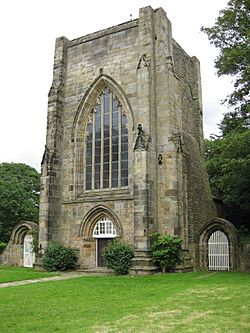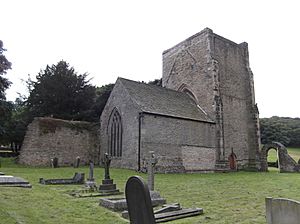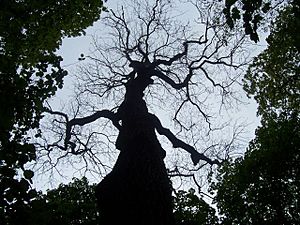Beauchief Abbey facts for kids
Quick facts for kids Beauchief Abbey |
|
|---|---|

Beauchief Abbey main tower
|
|
| Lua error in Module:Location_map at line 420: attempt to index field 'wikibase' (a nil value). | |
| Location | City of Sheffield, South Yorkshire, England |
Beauchief Abbey is an old monastery building in the southern part of Sheffield, England. Today, it serves as a local church. The name Beauchief is pronounced bee-chiff. It has a long and interesting history, going back many hundreds of years.
Contents
History of Beauchief Abbey
Beauchief Abbey was started by a man named Robert FitzRanulph de Alfreton. Historians believe it was founded sometime before 1176. The abbey was dedicated to Saint Mary and Saint Thomas Becket. Thomas Becket was an important religious figure who became a saint in 1172.
The abbey belonged to a special group of monks called the Premonstratensian order. This order was founded by Saint Norbert of Xanten in France. Members of this group are often called White Canons because of their white robes. Beauchief was a small abbey, usually home to about 12 to 15 canons (monks) and some lay brothers. It had all the usual buildings, like a church, cloisters, a meeting room (chapter house), sleeping quarters (dormitory), and a dining hall (refectory). A nearby stream provided water for the abbey and its fish ponds.
Like many monasteries, Beauchief Abbey was not just a religious place. It was also a busy center for work and industry. The monks were involved in farming on their land. They also managed iron smelting (making iron), mining, and wood industries. They even ran mills on the River Sheaf. This river is actually where the city of Sheffield gets its name!
The abbey was closed down in 1537 during a time called the Dissolution of the monasteries. This was when King Henry VIII closed many monasteries in England. After it closed, the abbey's land became the property of Sir Nicholas Strelley. Later, in 1671, Edward Pegge built Beauchief Hall. He used stones from the ruined abbey to build his new hall. In 1923, a man named Frank Crawshaw bought the estate. He sold some land for houses, but he gave a large part of it to Sheffield City Council.
Beauchief Park Today
Today, only the western tower of the old abbey remains. There are also some other ruins, like a wall, nearby. The tower is now connected to a chapel that was built in the 1600s. What's left of the abbey is protected as a Scheduled Ancient Monument. This means it's an important historical site. You can still see the foundations of other old buildings and the medieval fishponds.
Much of the original abbey land is now used for two golf courses: Abbeydale Golf Club and Beauchief Golf Club. However, several areas of ancient woodland (very old forests) still exist. These include Parkbank Wood, Old Park Wood, Little Wood Bank, Gulleys Wood, and Ladies Spring Wood. There are public footpaths that let you walk through the estate, including across the golf courses and through the woods. The Sheffield Round Walk also passes through this area.
Ladies Spring Wood (Totley Wood)
This is an old, curved forest with many deciduous trees (trees that lose their leaves). It sits on a steep bank facing the River Sheaf. In the past, this wood was managed for "coppicing with standards." This is a way of cutting trees to make them regrow, while leaving some taller trees. You can still find old charcoal platforms and pits where charcoal was made.
Today, Sheffield City Council manages the wood for wildlife and for people to enjoy. There are two public footpaths running through it. The main trees are sessile oak, birch, and rowan on the higher parts. Lower down, near the river, you'll find ash and alder. You might also see other types of trees. The upper part of the wood has many rhododendrons.
This wood is home to many birds. You might spot dippers by the river. Several kinds of hole-nesting birds live here too, like nuthatches and different types of woodpeckers: the green woodpecker, the great spotted woodpecker, and the lesser spotted woodpecker.
There's strong evidence that Ladies Spring Wood is a very old, "primary ancient woodland." Here's why:
- The name: Spring is an old Anglo-Saxon word for coppicing. This suggests the wood has been here and managed for hundreds of years.
- The shape: The edges of the wood have many bends and zig-zags. This often happens when land around a forest is slowly cleared over a long time.
- The location: The River Sheaf on its western side used to be a very important boundary. It was the border between different parishes, and even between the old Anglo-Saxon states of Mercia and Northumbria. Forests on such old boundaries were often left untouched.
- No signs of early settlements: There is no evidence of old villages or farm fields within the wood.
Because of its important wildlife, this wood has been named a Site of Special Scientific Interest (SSSI) under the name "Totley Wood."
Parkbank Wood
Parkbank Wood is another old, mature forest. It has been used more actively by people in the past, so it might not be as old as Ladies Spring Wood. You can still find signs of old charcoal making here, like charcoal hearths and Q-pits. There's also evidence of old quarrying (digging for stone) and boundary ditches. This might mean that parts of the area were once cleared for farming. Today, this wood is mostly made up of mature sessile oak trees. Public footpaths run through it, including the Sheffield Round Walk.
Even though the parkland has been changed for the golf courses, you can still see signs of medieval ridge and furrow farming. This is a pattern of raised and lowered strips of land from old farming methods.



